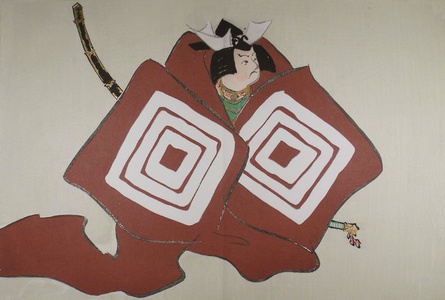| Method | Woodblock (nishiki-e) |
| Artist | Kamisaka Sekka (1866 - 1942) |
| Published | [Kyoto-shi: Geiso-do, 1910] |
| Dimensions | [11 1/2 x 17 1/2 inches] |
| Notes |
Series: Momoyogusa: A World of Things Publisher: Geiso-do Among fans of the Japanes Kabuki theatre the play Shibaraku is maybe the best known and the most popular one. The simple plot and the spectacular costume of the hero are among the reasons for its popularity. Shibaraku is one of the kabuki juhachiban, the 18 kabuki plays of Ichikawa Danjuro. The plot is rather simple and has only minimal but spectacular action. It is about the fight of good and evil and how the "good" prevails at the last moment. The evil and power-hungry Kiyohara Takehira has captured several innocent and virtuous but defenseless people. He threatens to kill them unless they join forces with him. And at the very last moment, when everything seems lost for the good guys, suddenly a thundering voice comes from behind the audience and shouts "shibaraku", meaning "wait a moment" in Japanese. Then steps in the hero and saviour, Kamakura Gongoro Kagemasa, in a huge and impressive costume on the long walkway running from the back of the auditorium to the stage. The costume of the hero is designed to make him look bigger and more impressive. For this reason the sleeves are enlarged by a kind of bamboo construction, sometimes supported by two assistants on the stage. The white and red stripes of the kumadori signal the good and noble and powerful character of the hero. Shibaraku is one of the 18 plays of kabuki juhachiban that still today may be played only by the members of the Ichikawa family. This print perhaps shows Kagemasa in his mie pose, the culminating highlight of a Kabuki play. This pose is the climatic freezing of an action. The actor remains completely motionless. His eyes are widely opened and crossed. Striking the mie pose is regarded a high art by Japanese Kabuki fans and is a challenge for any actor. Gold coloured pigment delineates the metallic sheen of the sheathed sword and ornately decorated inner garment. Momoyogusa: A World of Things is regarded as Sekka's masterpiece. The three volume series, produced between 1909 and 1910, features a total of sixty-images on a wide variety of subjects, and is a fantastic example of Sekka's combination of the traditional Rimpa school of painting with western and modern interests and techniques. Kamisaka Sekka (1866 - 1942) was an important artistic figure during the early Meiji era in Japan. Connected with the traditional Rimpa school of art, Sekka is often recognised as the last master of the tradition. Traditional styles such as Rimpa, however, became unpopular during Sekka's period, so a bonding of traditional craft and modernism was implemented. In 1901, the Japanese government sent Sekka to Glasgow, where he was heavily influenced by Art Nouveau, and sought to learn more about Japonism - the influence of Japanese art and aesthetics upon Western culture. Following his return to Japan, Sekka began teaching at the recently opened Kyoto Municipal School of Arts and Crafts, where he was able to experiment with western styles, methods, and interests, and in turn, combine them with his otherwise traditional Japanese work. Although traditionally Japanese in subject matter, Sekka's work has both western and modern aesthetics. Condition: Excellent condition. Pressed vertical crease, as issued. Thinning to left and right edges on verso. |
| Framing | mounted |
| Price | £250.00 |
| Stock ID | 42150 |

